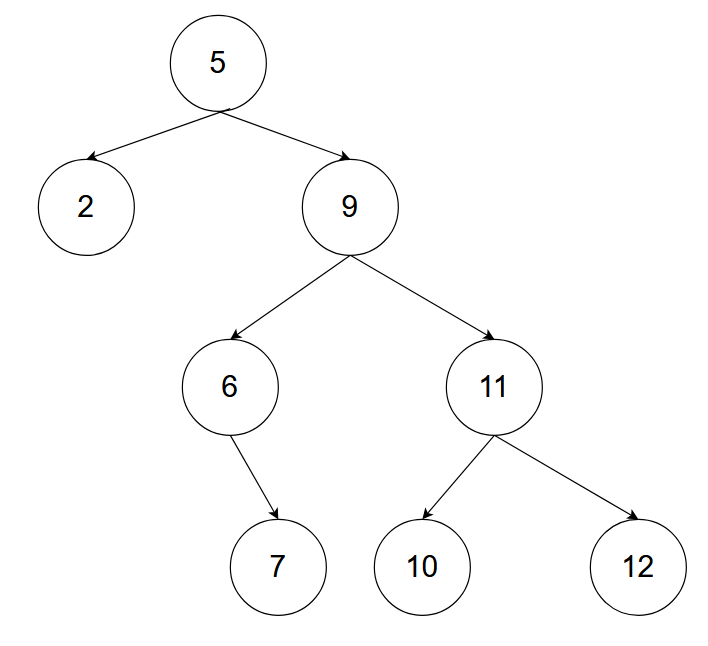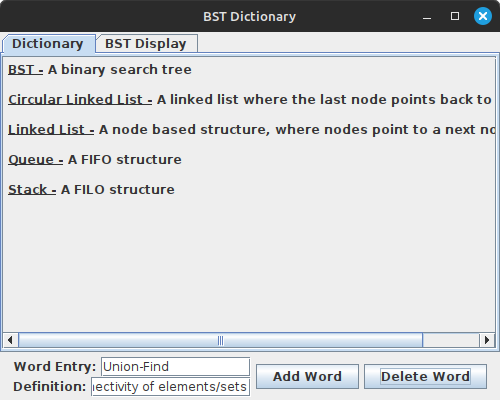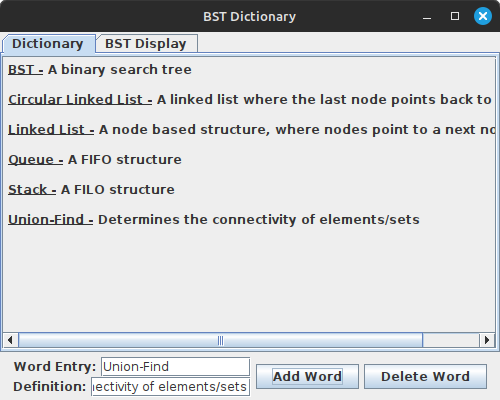Looking for Help with Assignments?
-RUCats has 80 hours of tutoring available online and in-person. Check the tutoring tab in Canvas!
-Instructors and Lead TAs have a combined 10 hours of Office Hours, open to all sections. See times/locations here.
-Piazza (found in the Canvas sidebar) provides fast support from Course Staff and other Students. Be sure to search to see if someone has asked a similar question!
-If you need a computer to complete work on, iLab machines can be found in the CSL (Hill 252) and surrounding rooms.
BST Dictionary Delete - 30 Course Points
The purpose of this lab is to learn how to implement recursive Hibbard deletion for a BST.
Start your assignment early! You need time to understand the assignment and to answer the many questions that will arise as you read the description and the code provided.
Refer to our Programming Assignments FAQ for instructions on how to install VSCode, how to use the command line and how to submit your assignments.
The assignment has one component: Coding (30 points) submitted through Autolab.
Lab 2 Review
Binary search trees are recursive structures that start off at a node and then branch off into different levels. They store items using keys for comparison — you can’t have duplicate keys in a BST.
Since there are different ways we can branch off to in a BST, we can’t simply do a linear traversal like we have with arrays and linked lists. We’ll have to use algorithms that traverse deeper into the tree to find all nodes.
Specifically, you stored words and definitions to implement a dictionary using a BST. Words will serve as the keys, and you’ll use lexicographic order (as .compareTo does) to determine orders and comparisons. For instance, “Data” should be to the left of “Structure” if “Structure” is the root.
WordNode.java is a class that stores words and definitions, as strings. This class also stores left and right children. You’ll use getters and setters in order to access the words, definitions, and children. Meanwhile, BSTDictionary.java is where you will write your solution code.
In this lab, you will implement Hibbard deletion, to add a remove word function to the dictionary.
Overview
When deleting from a BST, we need to decide how to handle the gap we create. In a linked list, we can simply fill in that gap with the next node. But BST nodes have two children, so which should we choose?
We can use a method called Hibbard Deletion, which says:
- If a deleted node has no children, simply unhook it from its parent.
- If a deleted node has one child, replace it with that child.
- If a deleted node has two children, replace it with its inorder successor
- An inorder successor is the next node in sequence. i.e. the smallest node greater than the current node (aka the smallest node in the target’s right subtree)
- To find the inorder successor of a node: move once to the right, then as far left as possible.

i.e. In the example above, the inorder successor of 4 would be 5. This is because 5 is the smallest node in 4’s right subtree (aka the smallest node in the subtree starting with 9).
We can also see this by listing the entire tree’s inorder traversal, then choosing the key directly after our target:
2 4 5 6 7 9 10 11 12
So after deleting the target, the tree would look like this:

Directions:
- DO NOT add new import statements.
- DO NOT add any new class attributes
- DO NOT change any of the method’s signatures.
- DO NOT modify the given constructor.
To complete this lab, you must implement the removeWord() method below. The method signature is already given, do not modify these or add any new ones.
addWord [PROVIDED]
This method is provided for you, and inserts a node containing a word and definition into the BST rooted at the instance variable “root”. It updates that instance variable if the tree is empty; otherwise it follows BST insertion rules to insert a node in its proper position.
-
Words with names greater than a node’s name are stored to the right of the node, otherwise they are stored to the left. We compare based on word names: we use the compareTo() method to determine where to place words lexicographically (ie. comparing strings).
findMin [PROVIDED]
This is a helper method for your deletion, which returns the minimum node of a tree.
This can be used to find the inorder successor of a target node, by calling findMin on the target’s right child.
DO NOT modify this method.
removeWordHelper
To complete this method:
We will create recursive cases to handle traversal and deletion. You should use an if-elseif-elseif-else structure to fill out the following.
Base Case: if curr == null
- return null
First Case: the target word is to the left of curr (word.compareTo(curr.getWord()) < 0)
- Then, set curr’s left child, to removeWordHelper(curr.getLeft(), word)
Second Case: the target word is to the right of curr (word.compareTo(curr.getWord()) > 0)
- Then, set curr’s right child, to removeWordHelper(curr.getRight(), word)
Final Case (when the target node is found):
- If curr has no children (left and right are both null), return null.
- Else if curr’s left child is null, return the right child instead.
- Else if curr’s right child is null, return the left child instead.
- ELSE (when curr has both a left and a right child)
- Get a pointer to the minimum node of curr’s right subtree (the inorder successor). You can do this by calling findMin() with curr’s right child.
- Create a new temp WordNode, and set its word/definition to be the same as the inorder successor you just found.
- Set curr’s right child to be a recursive call to removeWordHelper(curr.getRight(), temp.getWord())
- This will delete the temp node from its original spot, allowing you to use it to replace your actual target.
- Set your temp node’s left child to be curr’s left child
- Set your temp node’s right child to be curr’s right child
- return temp
After all of the cases end, return curr.
Driver
Once you implement your code, you can run the Driver.java file and interact with the driver. It’ll show two tabs: “Dictionary” and “BST Display”.
You can add words and definitions, and see all words added in the Dictionary tab, while the BST Display tab will allow you to visualize the BST.
Here’s an example of how the driver works:
The Dictionary tab shows all words and definitions.
You don’t have to input full definitions for each word each time you test – remember that our tree deletion doesn’t use values, only keys (word names).
NOTE: The Traversals tab from Lab 6 was removed
The BST Display tab will allow you to see the BST generated by inserting all nodes. You might have to resize or scroll to see all – use the scrollbars, don’t zoom.
You can click the “Delete Word” button to call removeWord() on the tree, for the target word. Make sure you spell the word exactly how you entered it, including capitalization and whitespace.
After deleting “Union-Find”:

Writing JUnit Tests
You do not have to submit this, this is for you to test your own code.
In the main project folder, there exists a “test” folder next to the “src” folder. This contains a JUnit test class, which can run and test pieces of your code. To compile and run these tests, you must install the Test Runner extension. See the Programming FAQ for more info on VScode extensions.
You must fill the deletion test in. Once you do, remove the fail() statements at the bottom and run.
You are provided with a premade JUnit test class. You can finish writing the test methods, by using JUnit test methods (assertTrue(), assertFalse(), assertEquals()) in order to test your code.
If you’d like to use unit tests, you can:
- Instantiate a new BSTDictionary object.
- Call .addWord on any words you’d like to insert (remember that BSTs follow specific ordering rules).
- Delete any node(s)
- You can reuse any traversal from Lab 6 to test your code. Create an array or ArrayList that stores the expected order of nodes as a result of the traversal. Make sure the traversal itself is correct!
- Compare the traversal of your tree after removal to the ArrayList you made.
Tests not running?
First, make sure you’re in the right folder and the tests are implemented. Next, if you have the “Code Runner for Java” or Oracle “Java” extension, make sure you uninstall those extensions. Remember that you must fill in the tests yourself.
VSCode Extensions
You can install VSCode extension packs for Java. Take a look at this tutorial. We suggest:
Importing VSCode Project
- Download BSTDictionaryDelete .zip from Autolab Attachments.
- Unzip the file by double-clicking.
- Open VSCode
- Import the folder to a workspace through File > Open Folder
Executing and Debugging
- Use the run option in VS Code to run this program – right click BSTDictionary.java and select Run Java. It’s harder to use the terminal as the commands differ based on OS.
- NOTE: if you have BSTDictionaryDelete (2) -> BSTDictionaryDelete or CS112 -> BSTDictionaryDelete in VS Code, open the INNERMOST BSTDictionaryDelete through File -> Open Folder.
Before submission
COMMENT all printing statements you have written from BSTDictionary.java, and make sure you’re NOT submitting the Traversals lab.
Collaboration policy. Read our collaboration policy here.
Submitting the assignment. Submit BSTDictionary.java separately via the web submission system called Autolab. To do this, click the Labs and Assignments link from the course website; click the Submit link for that assignment.
Getting help
If anything is unclear, don’t hesitate to drop by office hours or post a question on Piazza.
- Find instructors office hours here
- Find head TAs office hours here
- In addition to office hours we have the Coding and Social Lounge (CSL) , a community space staffed with community managers who are undergraduate students further along the CS major to answer questions.
By Colin Sullivan

